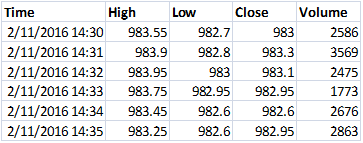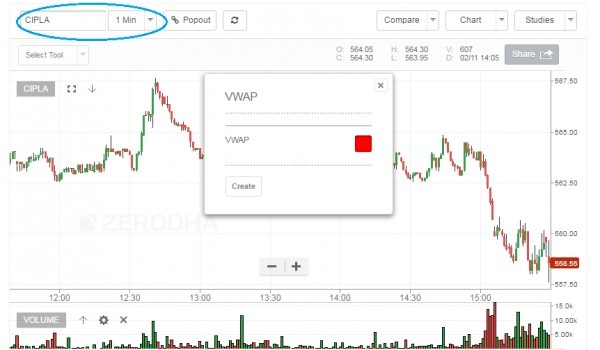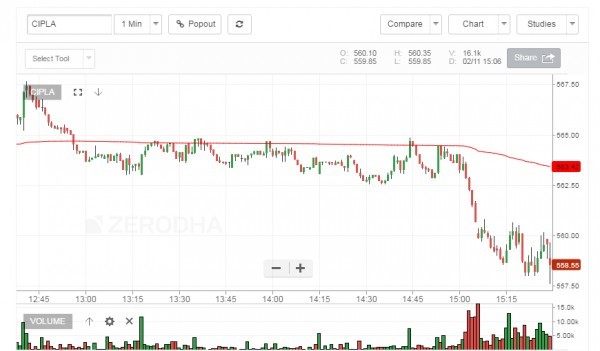VWAP is one of the simplest indicators to use. It works on the principle of averaging the traded price in terms of the volume traded. Let me give you an example of to help you understand this better.
Here is how Infy traded between 14:30 and 14:35 on 2nd Nov 2016 –

The data is quite simple to understand, for example, at 14:32, 2475 shares were traded, it made a high of 983.95, low of 983, and closed the minute at 983.1.
Now, we use this data and compute the VWAP price. In order to do this, we calculate the following –
1) Typical price = which is the average price of High, Low, and close
2) Volume Price (VP) = we get this by multiplying the typical price with its volume
3) Total VP = This is a cumulative number, which is got by adding the current VP to the previous VP
4) Total volume = This is again a cumulative number, which is got by adding the current volume to the previous volume
5) VWAP = We get this VWAP number by dividing the Total VP by Total Volume. The resulting number indicates the average traded price, weighted by volume.
Let’s do the math on Infy data –

As you see, the VWAP is a dynamic number, changing based on how the trades flow in.
How to use the VWAP?
1) VWAP is an intraday indicator, use it on minute charts. Often when you plot this, you will notice a jump at 9:15 AM, when compared to previous day’s data. Ignore this jump as it means nothing
2) VWAP is an average and like any indicators employing averages, this too lags the current market price
3) VWAP is used for 2 main reasons – to get a sense of intraday direction and to get a sense of the efficiency of order execution
4) If the current price is below VWAP, then the general opinion is that the intraday trend is down
5) If the current price is above VWAP, then the general opinion is that the stock is trending higher
6) If the VWAP lies in between the high and low, then the expectation is that the stock will remain volatile
7) If you intend to short a stock, then it is considered an efficient fill if you short the stock at a price higher than VWAP
8) Likewise, if you intend to go long on a stock, then it is considered an efficient fill if you go long at a price lower than VWAP
On Kite:
Open the chart of your preference and select VWAP from the studies drop down –

Note, VWAP can be applied only on intraday time frame and cannot be applied on EOD data.
Once you select the time frame (1 min, 5 mins, 10 mins etc), the engine calculates the VWAP and plots it on the chart as an overlay.

You can now visualize the VWAP and the current market price and plan your trades accordingly.
Btw, if technical analysis interests you, check out Varsity.
Good luck.